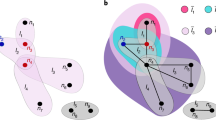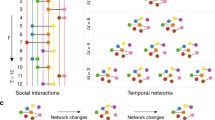Abstract
To explore evolutionary dynamics of collective behaviors within the interconnected population, previous studies usually map non-pairwise interactions to higher-order static networks. However, from human communications to chemical reactions and biological systems, interactions often change over time, which cannot be simply described by higher-order static networks. In this study, we introduce time effects into higher-order networks and correspondingly investigate the evolutionary dynamics of multiplayer snowdrift games on higher-order temporal networks. Specifically, extensive simulations from four empirical datasets reveal that (1) the temporal effect of higher-order networks can facilitate the evolution of cooperation; (2) the higher-order topology can enhance the emergence of cooperation within a certain range of parameters; (3) the contribution of temporal burstiness and participants burstiness to cooperation is reversed. Furthermore, we theoretically demonstrate that the higher-order structure will suppress the propagation of defection in temporal networks. Our findings offer a new avenue for studying the evolution of altruistic behaviors in realistic complex networks.
Similar content being viewed by others
References
Du J M, Wu B, Wang L. Aspiration dynamics in structured population acts as if in a well-mixed one. Sci Rep, 2015, 5: 8014
Zhou L, Wu B, Du J M, et al. Aspiration dynamics generate robust predictions in heterogeneous populations. Nat Commun, 2021, 12: 3250
Su Q, McAvoy A, Mori Y, et al. Evolution of prosocial behaviours in multilayer populations. Nat Hum Behav, 2022, 6: 338–348
Battiston F, Cencetti G, Iacopini I, et al. Networks beyond pairwise interactions: Structure and dynamics. Phys Rep, 2020, 874: 1–92
Benson A R, Abebe R, Schaub M T, et al. Simplicial closure and higher-order link prediction. Proc Natl Acad Sci USA, 2018, 115: 11221–11230
Perc M, Gómez-Gardeñes J, Szolnoki A, et al. Evolutionary dynamics of group interactions on structured populations: a review. J R Soc Interface, 2013, 10: 20120997
Li A M, Broom M, Du J M, et al. Evolutionary dynamics of general group interactions in structured populations. Phys Rev E, 2016, 93: 022407
Jian Q, Li X P, Wang J, et al. Impact of reputation assortment on tag-mediated altruistic behaviors in the spatial lattice. Appl Math Computation, 2021, 396: 125928
Wu B, Traulsen A, Gokhale C S. Dynamic properties of evolutionary multi-player games in finite populations. Games, 2013, 4: 182–199
Du J M, Wu B, Altrock P M, et al. Aspiration dynamics of multi-player games in finite populations. J R Soc Interface, 2014, 11: 20140077
Su Q, Zhou L, Wang L. Evolutionary multiplayer games on graphs with edge diversity. Plos Comput Biol, 2019, 15: e1006947
Govaert A, Cao M. Zero-determinant strategies in repeated multiplayer social dilemmas with discounted payoffs. IEEE Trans Automat Contr, 2020, 66: 4575–4588
Wang Z, Jusup M, Guo H, et al. Communicating sentiment and outlook reverses inaction against collective risks. Proc Natl Acad Sci USA, 2020, 117: 17650–17655
Guo P L, Wang Y Z, Li H T. Stable degree analysis for strategy profiles of evolutionary networked games. Sci China Inf Sci, 2016, 59: 052204
Alvarez-Rodriguez U, Battiston F, de Arruda G F, et al. Evolutionary dynamics of higher-order interactions in social networks. Nat Hum Behav, 2021, 5: 586–595
Xu Y, Feng M L, Zhu Y Y, et al. Multi-player snowdrift game on scale-free simplicial complexes. Phys A-Stat Mech Its Appl, 2022, 604: 127698
Li D, Song W B, Liu J M. Complex network evolution model based on turing pattern dynamics. IEEE Trans Pattern Anal Mach Intell, 2023, 45: 4229–4244
Shi D H, Chen Z, Sun X, et al. Computing cliques and cavities in networks. Commun Phys, 2021, 4: 249
Majhi S, Perc M, Ghosh D. Dynamics on higher-order networks: a review. J R Soc Interface, 2022, 19: 20220043
Schlager D, Clauß K, Kuehn C. Stability analysis of multiplayer games on adaptive simplicial complexes. Chaos, 2022, 32: 053128
Kumar A, Chowdhary S, Capraro V, et al. Evolution of honesty in higher-order social networks. Phys Rev E, 2021, 104: 054308
Capraro V, Perc M. Mathematical foundations of moral preferences. J R Soc Interface, 2021, 18: 20200880
Civilini A, Anbarci N, Latora V. Evolutionary game model of group choice dilemmas on hypergraphs. Phys Rev Lett, 2021, 127: 268301
Iacopini I, Petri G, Barrat A, et al. Simplicial models of social contagion. Nat Commun, 2019, 10: 2485
St-Onge G, Sun H, Allard A, et al. Universal nonlinear infection kernel from heterogeneous exposure on higher-order networks. Phys Rev Lett, 2021, 127: 158301
Skardal P S, Arenas A. Abrupt desynchronization and extensive multistability in globally coupled oscillator simplexes. Phys Rev Lett, 2019, 122: 248301
Ghorbanchian R, Restrepo J G, Torres J J, et al. Higher-order simplicial synchronization of coupled topological signals. Commun Phys, 2021, 4: 120
Neuhäuser L, Mellor A, Lambiotte R. Multibody interactions and nonlinear consensus dynamics on networked systems. Phys Rev E, 2020, 101: 032310
Sahasrabuddhe R, Neuhauser L, Lambiotte R. Modelling non-linear consensus dynamics on hypergraphs. J Phys Complex, 2021, 2: 025006
Chowdhary S, Kumar A, Cencetti G, et al. Simplicial contagion in temporal higher-order networks. J Phys Complex, 2021, 2: 035019
Wang H, Zhang H F, Zhu P C, et al. Interplay of simplicial awareness contagion and epidemic spreading on time-varying multiplex networks. Chaos, 2022, 32: 083110
Li X, Zhang X, Huangpeng Q Z, et al. Event detection in temporal social networks using a higher-order network model. Chaos, 2021, 31: 113144
Wu B, Zhou D, Fu F, et al. Evolution of cooperation on stochastic dynamical networks. Plos One, 2010, 5: e11187
Wu B, Zhou D, Wang L. Evolutionary dynamics on stochastic evolving networks for multiple-strategy games. Phys Rev E, 2011, 84: 046111
Du J, Wu Z R. Evolutionary dynamics of cooperation in dynamic networked systems with active striving mechanism. Appl Math Computation, 2022, 430: 127295
Li A M, Zhou L, Su Q, et al. Evolution of cooperation on temporal networks. Nat Commun, 2020, 11: 2259
Chiong R, Kirley M. Effects of iterated interactions in multiplayer spatial evolutionary games. IEEE Trans Evol Computat, 2012, 16: 537–555
Gokhale C S, Traulsen A. Evolutionary games in the multiverse. Proc Natl Acad Sci USA, 2010, 107: 5500–5504
Zhang J L, Cao M. Strategy competition dynamics of multi-agent systems in the framework of evolutionary game theory. IEEE Trans Circuits Syst II, 2020, 67: 152–156
Kibanov M, Atzmueller M, Scholz C, et al. Temporal evolution of contacts and communities in networks of face-to-face human interactions. Sci China Inf Sci, 2014, 57: 032103
Génois M, Barrat A. Can co-location be used as a proxy for face-to-face contacts? EPJ Data Sci, 2018, 7: 11
Fournet J, Barrat A. Contact patterns among high school students. Plos One, 2014, 9: e107878
Vanhems P, Barrat A, Cattuto C, et al. Estimating potential infection transmission routes in hospital wards using wearable proximity sensors. Plos One, 2013, 8: e73970
Génois M, Vestergaard C L, Fournet J, et al. Data on face-to-face contacts in an office building suggest a low-cost vaccination strategy based on community linkers. Net Sci, 2015, 3: 326–347
Wang H, Ma C, Chen H S, et al. Full reconstruction of simplicial complexes from binary contagion and Ising data. Nat Commun, 2022, 13: 3043
Iacopini I, Petri G, Baronchelli A, et al. Group interactions modulate critical mass dynamics in social convention. Commun Phys, 2022, 5: 64
Barabási A L. The origin of bursts and heavy tails in human dynamics. Nature, 2005, 435: 207–211
Takaguchi T, Masuda N, Holme P. Bursty communication patterns facilitate spreading in a threshold-based epidemic dynamics. Plos One, 2013, 8: e68629
Gauvin L, Génois M, Karsai M, et al. Randomized reference models for temporal networks. SIAM Rev, 2022, 64: 763–830
Nowak M A, May R M. Evolutionary games and spatial chaos. Nature, 1992, 359: 826–829
Petri G, Barrat A. Simplicial activity driven model. Phys Rev Lett, 2018, 121: 228301
Perra N, Gonçalves B, Pastor-Satorras R, et al. Activity driven modeling of time varying networks. Sci Rep, 2012, 2: 469
Li X-J, Li C, Li X. The impact of information dissemination on vaccination in multiplex networks. Sci China Inf Sci, 2022, 65: 172202
Acknowledgements
This work was supported by National Natural Science Foundation of China (Grant Nos. 62025602, 62173247, U1803263), Tianjin Municipal Natural Science Foundation (Grant No. 22JCZDJC00550), and Tianjin University of Technology Postgraduate Research Innovation Project (Grant Nos. YJ2239, YJ2240).
Author information
Authors and Affiliations
Corresponding authors
Rights and permissions
About this article
Cite this article
Xu, Y., Wang, J., Xia, C. et al. Higher-order temporal interactions promote the cooperation in the multiplayer snowdrift game. Sci. China Inf. Sci. 66, 222208 (2023). https://doi.org/10.1007/s11432-022-3738-3
Received:
Revised:
Accepted:
Published:
DOI: https://doi.org/10.1007/s11432-022-3738-3




